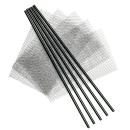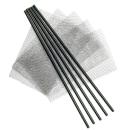Plastic rods for bodywork welding

Plastic welding rods for cars
-
 5600.1001Plastic rodABS - bag of 5
5600.1001Plastic rodABS - bag of 5 -
 5600.1002Plastic rodPP - bag of 5
5600.1002Plastic rodPP - bag of 5 -
 5600.1003Wire nettingbag of 5
5600.1003Wire nettingbag of 5
︾
Plastic welding rod for car bodywork :
Plastic welding rods, also known as filler plastic rods, are used in the hot air or plastic welding process. These rods are made from plastic materials that are compatible with those used in bodywork components, such as polypropylene (PP) or polyethylene (PE). Here's how they are generally used in the bodywork industry:
Choosing the right rod:
Select a plastic filler rod that is compatible with the type of plastic in the bodywork component you are going to repair. Rods are available in a range of colours to match the shade of the original material.
Preparing the area to be repaired :
Before starting the welding process, prepare the damaged area by removing contaminants, dirt and any other substance that could affect the quality of the weld.
Align the parts to be welded:
Make sure that the parts to be welded are correctly aligned. Plastic rods will be used to fill cracks, holes or damaged areas, providing additional material during welding.
Pre-heating the area:
Use a hot air gun to pre-heat the area to be repaired. The plastic should be hot enough to accept the plastic rod, but not so hot as to cause excessive deformation.
Inserting the plastic rod :
Once the area has been pre-heated, insert the plastic rod into the crack or area to be repaired. The heat from the hot air gun allows the rod to melt and fuse with the original plastic.
Smoothing and shaping:
Use appropriate tools to smooth and shape the melted material to achieve a uniform and aesthetically pleasing surface. This may include using special spatulas to shape the melt.
Cooling:
Allow the repaired area to cool naturally. It is essential not to handle the area until the plastic has completely cooled and hardened.
Cosmetic finishing:
If necessary, carry out finishing work such as Sanding and Paint to ensure that the repaired area blends seamlessly into the vehicle bodywork.
The use of plastic strips for bodywork welding makes it possible to carry out solid, aesthetic repairs to damaged plastic components. This technique is commonly used in the bodywork sector to restore the structural integrity of parts while maintaining their original visual appearance.
Use of bodywork plastic welding rods:
Plastic welding rods are generally used in the automotive bodywork sector to repair plastic components that have been damaged, such as bumpers, side panels, grilles and other bodywork components. Here are some specific contexts in which plastic welding rods can be used effectively:
Crack and break repairs:
Plastic welding rods are used to repair cracks and breaks in plastic body components. They provide a filler material that fuses with the original plastic during the welding process.
Hole filling:
If a plastic component has holes or gaps, plastic welding rods can be used to fill these missing areas, creating a continuous, repaired surface.
Bumper repair:
Bumpers are often made of plastic, and plastic welding rods are used to repair damage such as cracks, scratches or deformations caused by minor collisions.
Side panel restoration:
Plastic welding rods can be used to restore damaged plastic side panels. They help to fill in imperfections and restore the component to its original shape.
Repairing grills and grilles:
Plastic welding strips can be used to repair damaged grilles and grilles, helping to restore the original appearance and functionality.
Fixing interior components:
Parts of the vehicle interior, such as plastic interior trim panels, can also be repaired using plastic welding rods.
Repairing plastic linings:
If plastic linings have scratches, scuffs or other minor damage, plastic welding rods can be used to make localised repairs.
Restoring plastic headlights:
Plastic headlights, which are subject to wear from weathering, UV rays and impact, can be restored using plastic welding rods to repair cracks and discoloured areas.
It is important to note that the use of plastic welding rods requires some expertise in plastic welding techniques. Trained bodywork professionals are generally familiar with these procedures and can apply them correctly to achieve durable and aesthetically pleasing results.
Focus on the plastic welding products available on the Carross website:
Plastic welding rods and metal fillets are two types of material used in different contexts due to their distinct properties. Here is a comparison between the two:
Plastic rods :
Material : Plastic rods are made from plastic materials such as polypropylene (PP) or polyethylene (PE).
Main use: They are used in plastic welding processes to repair plastic components, particularly in the car body industry. These rods provide a filler material that fuses with the original plastic during the welding process.
Applicability : Plastic welding rods are specifically designed for use with plastic welding tools, such as hot air guns.
Variety of colours: They are available in a variety of colours to match the original material of the plastic component.
Metal threads :
Material : Metal threads are made from metallic materials, such as steel, aluminium or other alloys.
Main use: Metal threads are used in fastening and bonding applications in a variety of sectors. They can be used to assemble metal parts or to reinforce structures.
Applicability : Metal threads can be used in a wide range of applications, from construction and manufacturing to mechanical repairs.
Mechanical strength : Metal threads are renowned for their mechanical strength and ability to withstand heavy loads. They are often used in applications where strength and durability are essential.
In short, the main difference lies in the base material and the specific application. Plastic rods are used to repair plastic components by plastic welding, while metal threads are fasteners used in a variety of applications where mechanical strength is crucial.